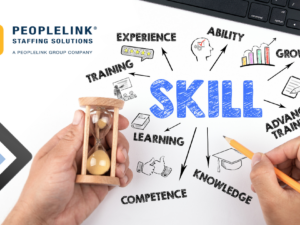
Why is it important?
If 2020 has taught us anything in the staffing world, it’s that we must find a new way of doing business. This includes getting creative in how we partner with our clients and engage with our talent. The global pandemic became “real” for us all in March of 2020. Organizations that were able to pivot to a remote workforce quickly and effectively were able to stay ahead of the current and set themselves up for a period of sustained growth.
One of the unintended benefits that has come from this terrible pandemic has been an awareness that new ways of delivering business results, no matter the industry, is essential. Organizations that were previously hesitant to entertain a remote workforce now realize it is a viable alternative to remain competitive in the race for talent. According to Stanford Research, an incredible 42% of the U.S. labor force was working from home full-time by June. Even by August, the fraction of entirely home-based work, despite a slight decline relative to earlier in the pandemic, remained very high at 20.3%, according to the Dallas Federal Reserve Bank.
What are potential wins for organizations that are able to make the right pivot? When physical geography is de-emphasized due to remote work capability, there is access to a more diverse workforce in greater supply. Kate Lister, President of Global Workplace Analytics, touts that an estimated 25-30% of the workforce will be working from home multiple days a week by the end of 2021. In keeping up with this plunge, people become the peak differentiator of every industry. Greater diversity creates ideas that spur growth. Teams are more effectively engaged. Expensive, unwanted turnover rates drop significantly. Your employees and your business collectively experience a win/win.
Having proven, repeatable onboarding steps is essential for riding the long-term wave of a successful remote work arrangement. Throughout the recruiting process, candidates form impressions quickly that are crucial for a long-term employment partnership.
What are the crucial steps to successfully onboard a new candidate?
1) Ensure that all necessary equipment is delivered early. Too often, candidates are stressed the week before starting a new position because they are unsure how to perform their job duties. An important unknown to remove is the physical equipment necessary. Make sure that new resources have the necessary setup at home. IT equipment should be delivered with enough time to test access to all applications that the candidate needs to perform their duties. The Friday before the start date is too late.
Gather requirements with the candidate on what they need to be successful. Would they benefit from a second monitor? Is their email set up correctly? Do they have access to all the appropriate applications? Are their security protocols configured? Do they know who to turn to if they have issues? What types of communication are used to interact with leadership and teammates?
This is one of the greatest areas of uncertainty that can provide a negative initial impression for a candidate. On the bright side, it is also one that can be easily eliminated through a well-designed, repeatable process that ensures everyone is operating on the same wavelength.
2) Communication of the organization’s mission, vision, and values during the recruitment process. One of the keys to a successful remote engagement is to recruit to an organization’s mission, vision, and values. Inherently, leaders are placing an increased trust in remote workers due to lack of direct oversight. Identifying candidates that fit from a values perspective is crucial. In addition, a candidate must be propelled by the mission and vision of an organization and be able to identify with that “why” factor!
3) A clearly defined, pre-communicated schedule for the first week. This is another often over-looked aspect of onboarding. Everyone that starts a new job is dealing with some level of anxiety, much of which is caused by the unknown of what they will be doing while they initially settle in.
A simple step to take during the onboarding process is to set up a time to go over the first week in detail. Lay out a calendar that can be given to the candidate so they can prepare their thoughts ahead of time. Knowing what the first week looks like from a schedule perspective eliminates much of the unknown and reduces the ramp up period, ultimately saving both time and money!
4) 30-60-90 day expectations laid out during the onboarding process. As mentioned in the previous point, every candidate has anxiety stepping into a new role. Too often, we forget what that feels like. Another key action to minimize this anxiety is to provide absolute clarity in the expectations of the candidate. Successful leaders go so far as to spell out these expectations in offer letters! If a new employee can step into a role knowing what is expected of them, they can plan and be set up to succeed. Unclear expectations lead to disengaged employees and some of that expensive, unwanted turnover.
5) Build trust. This point cannot be understated. Trust is at the crest of building a high-functioning team. There are several tactics for building a trusting culture:
- Introduce the new employee to the team ASAP. Don’t make the initial intro about work. Make this intro about getting to know each other on a personal level by having every individual on the team share something about themselves. This tactic is not a box to be checked once – it must be repeated consistently. Continue to start all team meetings with a “get to know you” exercise. Make some fun and light-hearted. Make some serious to understand the why behind each individual.
- Provide collaboration opportunities. Actively schedule opportunities for the new employee to collaborate with different members of the team. One of the quickest ways to shorten the ramp up period and establish long-term engagement is to provide opportunities to accomplish a task together with a teammate. Emotional connections are established through joint success that will keep the workplace current flowing strong.
- Focus on the culture. The first step here is to be aware of what the impression is of your current culture. Next, envision what you want your ideal culture to look like and onboard with those goals in mind. Communicate the vision for that culture consistently and be sure to demonstrate those values in all interactions.
- Engagement is critical. A remote candidate is at an increased risk of disengagement when they are isolated and new to the team. Go above and beyond to engage with the new resource and be sure to include them in all appropriate meetings. Use video for the majority of interactions – with the camera on! Set that expectation immediately so that no one shies away.
Remember that people are typically our most valuable resource and turnover is costly in every aspect. Navigating the ocean of remote onboarding is difficult, but having a repeatable process focused on the areas above can ensure that no one gets caught in the undertow. Working together, we can use these strategies to differentiate an organization in an ever flowing and very competitive employment marketplace! Please reach for us at sales@peoplelinkgroup.com.





